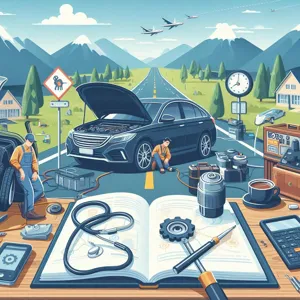In a world that thrives on mobility and freedom, accessibility in transportation is essential for empowering individuals of all abilities.
Finding the right vehicle that combines comfort, functionality, and style can be a challenge for those with mobility needs, but it is not impossible. As automakers increasingly recognize the importance of inclusivity, a new wave of accessible cars is emerging, designed to cater to diverse lifestyles and ensure that everyone can hit the road with confidence. In this blog post, we’ll explore the top 10 accessible cars that stand out for their innovative designs, user-friendly features, and commitment to comfort. Whether you’re seeking a family-friendly option, a sleek urban ride, or a robust adventure vehicle, these cars are paving the way for a more inclusive driving experience that prioritizes both functionality and style. Join us as we drive towards a future where everyone can enjoy the open road!
1. Understanding Accessible Vehicles: What Makes a Car Inclusive?

When we talk about accessible vehicles, we are referring to cars specifically designed or modified to accommodate the needs of individuals with disabilities. These vehicles prioritize inclusivity, ensuring that everyone, regardless of their physical abilities, can enjoy the freedom of mobility. But what exactly makes a car truly accessible?
At the heart of an accessible vehicle are various features that enhance usability and comfort. One key element is the entry and exit system; cars equipped with ramps or lifts allow individuals who use wheelchairs to easily get in and out without the need for assistance. For those who can transfer from their wheelchair to a seat, wider door openings and lower floor designs can make a significant difference, reducing the effort required to enter the vehicle.
Additionally, the interior layout plays a crucial role in ensuring inclusivity. Spacious cabins that allow for easy maneuverability, adjustable seating options, and secure wheelchair tie-downs are essential features that cater to diverse needs. Controls that are easy to reach and operate are also vital; this includes intuitive dashboard layouts, hand controls for those who cannot use foot pedals, and voice-activated technology that minimizes the need for physical interaction.
Moreover, accessibility extends beyond physical features. It encompasses the overall user experience, which includes thoughtful design elements like tactile buttons for the visually impaired, adjustable mirrors, and premium sound systems for those with hearing difficulties. A truly inclusive vehicle also considers safety features, such as adaptive cruise control and collision warning systems, which can provide added confidence for drivers with varying levels of ability.
In essence, understanding accessible vehicles involves recognizing the myriad ways in which thoughtful design can break down barriers and promote inclusivity. By prioritizing comfort, usability, and safety, manufacturers can create cars that empower individuals with disabilities to reclaim their independence and enjoy the open road without limitations.
2. Importance of Accessibility in the Automotive Industry
The importance of accessibility in the automotive industry cannot be overstated. As our society becomes increasingly aware of the diverse needs of all individuals, the automotive sector is stepping up to the challenge of creating vehicles that cater to everyone, regardless of their physical abilities. Accessibility in cars goes beyond mere compliance with regulations; it embodies a commitment to ensuring that mobility is a right, not a privilege.
For many individuals with disabilities, the ability to drive or be a passenger in a vehicle is pivotal for independence and quality of life. Accessible cars are designed with features that accommodate various needs, such as wider door openings for easier entry and exit, adjustable seating that can be modified for different heights and mobility challenges, and intuitive controls that can be operated without requiring extensive physical effort. These enhancements not only make driving safer but also provide a sense of dignity and empowerment to those who may otherwise feel marginalized.
Furthermore, the push for accessibility in the automotive industry reflects a broader societal shift towards inclusivity. As manufacturers recognize the growing market of consumers with disabilities, they are increasingly incorporating universal design principles into their vehicles. This not only helps in catering to a wider audience but also fosters brand loyalty among customers who value companies that prioritize accessibility.
In summary, prioritizing accessibility in the automotive industry is essential for creating an inclusive society where everyone can enjoy the freedom of mobility. By investing in accessible vehicle designs, manufacturers not only enhance the driving experience for many but also pave the way for a more equitable future where all individuals can travel with comfort and confidence.
3. Key Features to Look for in Accessible Cars

When searching for an accessible car, it’s essential to prioritize specific features that ensure comfort, safety, and ease of use for all passengers, particularly those with mobility challenges. Here are some key features to consider:
**1. Wheelchair Accessibility:** Look for vehicles that offer a low floor and a wide entry point, such as a ramp or lift, to facilitate easy access for wheelchair users. The ramp should be sturdy, with a gentle incline to ensure safe entry and exit.
**2. Spacious Interior:** Ample space within the cabin is crucial for maneuverability. A vehicle with generous headroom and legroom allows for a comfortable ride and ease of movement for passengers who may need assistance getting in and out.
**3. Secure Wheelchair Tie-Downs:** Safety is paramount. Quality accessible cars come equipped with secure wheelchair tie-down systems that keep the wheelchair firmly in place during travel. These systems should be easy to use, allowing for quick and secure fastening.
**4. Power Mobility Options:** Some vehicles offer power sliding doors and power ramps, which can be particularly beneficial for caregivers and passengers with limited strength. These features should be intuitive and easily activated, ensuring hassle-free access.
**5. Adaptive Controls:** For drivers with disabilities, adaptive controls can make a significant difference. Look for vehicles that offer hand controls, joystick steering, or other modifications that cater to specific needs, ensuring that driving is safe and comfortable.
**6. Lowered Floor Plans:** A lowered floor design can enhance headroom and make it easier for passengers to enter and exit the vehicle. This design is especially important for those using wheelchairs, as it reduces the height they need to navigate.
**7. Visibility and Mirrors:** Good visibility is crucial for safe driving. Features such as large windows, adjustable mirrors, and backup cameras help improve sightlines and reduce blind spots, assisting the driver in safely navigating their surroundings.
**8. Comfort Features:** Never underestimate the importance of comfort. Look for cars that offer adjustable seating, climate control, and high-quality materials to ensure a pleasant ride for everyone on board.
**9. Safety Ratings:** Before making a purchase, check the vehicle’s safety ratings. Features such as multiple airbags, stability control, and advanced safety systems provide added peace of mind, particularly for families with special needs.
**10. Customization Options:** Consider vehicles that allow for customization to suit your specific needs. Whether it’s additional storage for mobility aids or enhanced seating options, having the flexibility to adapt the vehicle can make a significant difference in everyday use.
Choosing the right accessible car requires thoughtful consideration of these features, ensuring that both the driver and passengers can enjoy a safe, comfortable, and inclusive driving experience. By prioritizing accessibility, you’re not just selecting a vehicle; you’re embracing a lifestyle that values inclusivity and independence for all.
4. Criteria for Our Top 10 List: What We Considered
When compiling our Top 10 Accessible Cars list, we took a comprehensive approach to ensure that every vehicle featured not only meets but exceeds the expectations of drivers and passengers with diverse abilities. Our criteria were meticulously crafted to reflect the essential elements of accessibility, comfort, and practicality.
**1. Accessibility Features:** First and foremost, we examined the specific accessibility features each vehicle offers. This includes wheelchair ramps, lift systems, and the ease of entering and exiting the vehicle. We prioritized vehicles with wide door openings, low step-in heights, and spacious interiors that accommodate mobility devices without hassle.
**2. Safety Standards:** Safety is paramount for all drivers, but it holds particular significance for those with mobility challenges. We evaluated the vehicles on their adherence to safety regulations, including crash test ratings, the availability of advanced driver assistance systems (ADAS), and features such as secure wheelchair tie-downs and seatbelt systems.
**3. Comfort and Usability:** Beyond accessibility, we considered the comfort level of each vehicle. This includes seating materials, legroom, climate control options, and noise insulation. Vehicles that offer adjustable seating configurations, easy-to-use controls, and intuitive technology scored higher on our list, as these factors contribute to an enjoyable driving experience.
**4. Versatility and Space:** We looked at the versatility of the vehicle, including cargo space for stowing mobility aids and personal belongings. Models that can seamlessly transition between being a family car and a mobility-friendly vehicle were favored, as they cater to a broader range of needs.
**5. Consumer Feedback:** Real-world experiences matter. We scoured reviews and testimonials from drivers and passengers with disabilities to gauge satisfaction levels. Their insights provided valuable context on how the vehicles perform in everyday situations and how well they meet accessibility claims.
**6. Innovation and Design:** Lastly, we considered the innovation behind each vehicle’s design. We looked for manufacturers who prioritize inclusivity in their engineering, showcasing advancements that make driving more accessible and enjoyable for everyone.
By combining these criteria, we aimed to create a diverse list that not only highlights the best accessible cars on the market but also emphasizes the importance of inclusivity in the automotive industry. Each vehicle on our list stands as a testament to the idea that comfort and accessibility should be a standard, not an afterthought.
5. Vehicle #1: Overview and Accessibility Features

### Vehicle #1: Overview and Accessibility Features
The first vehicle on our list of top accessible cars is the Honda Odyssey, a minivan that effortlessly combines functionality with comfort, making it an ideal choice for individuals and families with mobility challenges. With its spacious interior and thoughtful design, the Odyssey stands out as a leader in accessibility.
**Spacious Interior and Configurable Seating**
The Honda Odyssey boasts a roomy cabin that can comfortably accommodate up to eight passengers, allowing for easy maneuverability for those using wheelchairs or mobility aids. The second-row seats can be easily removed or repositioned, creating a flexible space that can be tailored to meet individual needs. The generous headroom and legroom ensure that everyone—whether seated or in a wheelchair—can enjoy a comfortable ride.
**Accessibility Features**
One of the Odyssey’s standout features is its low floor height, which simplifies entry and exit for passengers. The side sliding doors open wide to provide ample space, while the optional power-operated ramp makes it easy for wheelchair users to access the vehicle independently. The van also comes equipped with secure tie-downs that keep wheelchairs safely in place during travel, ensuring peace of mind for both drivers and passengers.
**Advanced Technology and Safety**
In addition to its accessibility features, the Honda Odyssey is packed with technology designed to enhance the driving experience for everyone. The intuitive infotainment system includes smartphone integration and voice recognition, allowing passengers to stay connected without distraction. Safety is paramount, and the Odyssey is equipped with a suite of advanced driver-assistance systems, including lane departure warning and adaptive cruise control, which contribute to a secure and confident driving experience.
In summary, the Honda Odyssey excels in blending accessibility with comfort and safety, making it a stellar choice for those seeking a vehicle that accommodates diverse mobility needs. Whether you’re navigating city streets or embarking on a family road trip, the Odyssey ensures that everyone can travel with ease and confidence.
6. Vehicle #2: Overview and Accessibility Features
**Vehicle #2: Overview and Accessibility Features**
The second vehicle on our list is the versatile and spacious Toyota Sienna, a standout choice for families and individuals seeking both comfort and accessibility. This minivan has been thoughtfully designed to cater to a wide range of mobility needs, making it a top contender in the realm of accessible vehicles.
At first glance, the Sienna boasts a sleek exterior that blends modern aesthetics with functionality. Its low floor and wide sliding doors provide easy entry and exit for passengers, including those who may rely on wheelchairs or mobility devices. The generous cabin space ensures that everyone can travel comfortably, without feeling cramped.
One of the key accessibility features of the Toyota Sienna is its optional ramp system. This innovative design allows for seamless loading and unloading, accommodating wheelchairs with ease. The ramp can be deployed with minimal effort, empowering users to gain independence while accessing the vehicle. Once inside, the spacious interior offers ample room for maneuverability, so passengers can comfortably navigate the cabin while seated.
In addition to physical accessibility, the Sienna also prioritizes technological advancements to enhance the driving experience for all users. The vehicle comes equipped with a user-friendly infotainment system, featuring voice-activated controls, which ensures that drivers can keep their eyes on the road while accessing navigation, music, and hands-free communication.
Safety is paramount in the Toyota Sienna, and it doesn’t skimp on features. With advanced driver-assistance systems, such as adaptive cruise control, lane departure warning, and automatic emergency braking, the Sienna is designed to provide peace of mind for drivers and passengers alike.
Overall, the Toyota Sienna exemplifies how a vehicle can be both accessible and stylish, proving that inclusivity and comfort can go hand in hand. Whether for daily commutes, family road trips, or errands around town, this minivan stands ready to meet the diverse needs of its users, making it a worthy contender in the quest for accessible transportation.
7. Vehicle #3: Overview and Accessibility Features

### Vehicle #3: Overview and Accessibility Features
The third vehicle on our list is the innovative **Honda Odyssey**, a minivan that has long been a favorite among families for its spaciousness and versatility. But what truly sets the Odyssey apart is its commitment to accessibility, making it an excellent choice for drivers and passengers with mobility challenges.
At first glance, the Odyssey impresses with its sleek, modern design, but it’s the thoughtfully engineered features that truly enhance its accessibility. The vehicle boasts a low step-in height, which makes entering and exiting the vehicle significantly easier for individuals using wheelchairs or those who require assistance. The sliding side doors open wide, providing ample space for maneuvering and ensuring that access is never a struggle.
Once inside, the Odyssey offers a spacious cabin that can comfortably accommodate up to eight passengers. The floor is designed with a flat surface, allowing for easy wheelchair access while still maintaining room for additional seating. For those who rely on mobility aids, the Odyssey can be equipped with a variety of adaptive technologies, including removable seating and tie-down systems that securely hold wheelchairs in place during transit.
In terms of technology, the Honda Odyssey doesn’t disappoint. The vehicle is equipped with an intuitive infotainment system featuring a large touchscreen display, voice recognition, and smartphone integration, making it easy for all passengers to stay connected and entertained on the go. Additionally, ample storage compartments are strategically placed throughout the interior, ensuring that essential items are always within reach.
Safety is paramount in the Odyssey, and it comes equipped with advanced safety features such as lane-keeping assist, collision mitigation braking, and blind-spot monitoring. These features enhance the driving experience for everyone, particularly for those who may need extra reassurance while on the road.
In summary, the Honda Odyssey is more than just a family vehicle; it is a beacon of inclusivity and comfort. With its array of accessibility features, spacious interior, and cutting-edge technology, the Odyssey stands as a testament to the automotive industry’s commitment to making driving a comfortable and enjoyable experience for everyone. Whether you’re running errands or embarking on a family adventure, the Honda Odyssey is designed to keep all passengers happy, safe, and engaged.
8. Vehicle #4: Overview and Accessibility Features
### Vehicle #4: Overview and Accessibility Features
The fourth vehicle on our list is the Honda Odyssey, a minivan that has long been a favorite among families and those seeking a spacious, comfortable ride. What sets the Odyssey apart is its thoughtful design focused on accessibility, making it a top choice for individuals with mobility challenges.
One of the standout features of the Honda Odyssey is its ultra-low floor, which significantly reduces the height needed to enter and exit the vehicle. This feature is particularly beneficial for wheelchair users and those with limited mobility, allowing for a smooth transition without the need for excessive lifting. The Odyssey also offers a power sliding side door that can be easily operated with the push of a button, providing effortless access for passengers, whether they are using mobility aids or not.
Inside the Odyssey, the spacious cabin is designed with flexibility in mind. The second-row seats can be configured to accommodate a wheelchair or scooter, enhancing comfort for all passengers. Additionally, the vehicle is equipped with multiple tie-down points, ensuring that mobility devices are secured safely during transit.
For those who prioritize technology, the Honda Odyssey boasts an intuitive infotainment system that includes features like Apple CarPlay and Android Auto, allowing for seamless connectivity with smartphones. This focus on user-friendly technology means that all passengers can stay entertained and connected throughout their journey.
Safety is paramount in the Odyssey, with advanced features such as lane-keeping assist, adaptive cruise control, and a comprehensive suite of airbags. The vehicle’s visibility is enhanced by its large windows and available rearview camera, making it easier for drivers to navigate through tight spots and crowded areas.
In summary, the Honda Odyssey stands out not just for its spaciousness and comfort, but for its unwavering commitment to accessibility. With its thoughtful design and array of features aimed at inclusivity, this minivan is not just a vehicle; it’s a gateway to freedom and adventure for all passengers. Whether you’re embarking on a family road trip or simply running errands around town, the Odyssey ensures that everyone can travel with ease and confidence.
9. Vehicle #5: Overview and Accessibility Features
### Vehicle #5: Overview and Accessibility Features
The fifth vehicle on our list is the 2023 Honda Odyssey, a minivan that has long been a favorite among families for its spacious interior and practical design. However, what sets the Odyssey apart in the realm of accessibility is its thoughtful array of features tailored specifically for individuals with mobility challenges.
At first glance, the Odyssey impresses with its sleek exterior and smooth lines, but the real magic happens once you step inside. The minivan boasts wide sliding side doors that open to reveal an expansive cabin, making entry and exit effortless for passengers of all abilities. The low floor height is particularly advantageous, allowing wheelchair users to comfortably access the vehicle without the need for cumbersome lifts.
Inside, the Odyssey is equipped with adaptive seating options that can be easily configured to accommodate various needs. The versatile Magic Slide seating system allows the second-row seats to be repositioned, providing additional space for maneuverability or creating room for a wheelchair. The seats are also designed with ample cushioning and support, ensuring a comfortable ride for everyone.
For drivers with disabilities, the Odyssey offers customizable controls that can be tailored to individual preferences. Features such as optional hand controls and a steering wheel that is adjustable for reach make driving more accessible. Furthermore, the vehicle comes with an intuitive infotainment system that includes voice command capabilities, allowing drivers to keep their focus on the road while managing navigation and entertainment.
Safety is paramount, and the Honda Odyssey does not disappoint. It is equipped with advanced safety features, including adaptive cruise control, lane-keeping assist, and a rearview camera with a wide-angle view, all of which contribute to a secure driving experience. Additionally, the vehicle provides ample storage space for mobility aids, whether it’s a folded wheelchair or other assistive devices, ensuring that families can travel with everything they need.
Overall, the 2023 Honda Odyssey exemplifies how thoughtful design and accessibility features can work hand-in-hand to create a vehicle that not only meets the needs of its diverse drivers and passengers but also enhances the joy of traveling together. Its commitment to inclusivity makes it a standout choice for those seeking both comfort and practicality on the road.
10. Vehicle #6: Overview and Accessibility Features
### Vehicle #6: Overview and Accessibility Features
The sixth vehicle on our list is the versatile and family-friendly Honda Odyssey. Known for its spacious interior and practical design, the Odyssey is an excellent choice for families and individuals who prioritize accessibility without compromising on comfort. This minivan is engineered to accommodate a wide range of needs, making it a top contender in the accessible vehicle market.
One of the standout features of the Honda Odyssey is its generous cabin space, which allows for easy entry and exit, even for those who may have mobility challenges. The sliding side doors open wide, providing a clear path for wheelchair users or those who require assistance. Additionally, the Odyssey can be equipped with a power ramp and wheelchair tie-downs, ensuring that passengers with mobility devices can travel safely and comfortably.
Inside, the Odyssey boasts adjustable seating configurations that make it easy to customize the space according to the needs of all passengers. The second-row Magic Slide seats can be repositioned to create more room for movement, while the available removable seats enhance flexibility for different scenarios, whether it’s a family road trip or a quick grocery run.
For enhanced visibility and safety, the Odyssey is equipped with an array of advanced safety features, including a rearview camera, blind-spot monitoring, and adaptive cruise control. These technologies not only assist the driver but also provide peace of mind to passengers, particularly those who may require additional assistance.
Moreover, the Honda Odyssey offers several convenience features that further enhance accessibility. The touch-screen infotainment system is intuitive and easy to navigate, with voice command capabilities that allow drivers to operate it hands-free. Additionally, the vehicle’s climate control system is designed for optimal comfort, ensuring that everyone can enjoy a pleasant ride regardless of external weather conditions.
In summary, the Honda Odyssey stands out as a prime example of a vehicle that embodies inclusivity and comfort. With its thoughtful design and range of accessibility features, it ensures that every journey—whether it’s to the store or a family outing—is enjoyable for all passengers. As we continue to explore cars that prioritize accessibility, the Odyssey serves as a testament to what can be achieved when manufacturers listen to the needs of every driver and passenger.
11. Vehicle #7: Overview and Accessibility Features
### Vehicle #7: Overview and Accessibility Features
As we continue our journey through the landscape of accessible vehicles, we arrive at Vehicle #7, a remarkable option that epitomizes the perfect blend of style, functionality, and inclusivity. This model has garnered attention not only for its sleek design but also for its thoughtful engineering tailored to meet the needs of all drivers and passengers, particularly those with mobility challenges.
At first glance, the Vehicle #7 stands out with its modern aesthetic, featuring smooth lines and a compact silhouette that belies its spacious interior. The car is designed with an emphasis on ease of entry and exit, making it an ideal choice for those who require additional support. Its wide, automatic sliding side doors open up to reveal a generous cabin space, allowing passengers to step in comfortably without feeling cramped.
One of the standout features of this vehicle is its low floor height, which significantly reduces the effort required to get in and out. This is complemented by an optional ramp that can be deployed at the push of a button, providing a seamless transition for wheelchair users or those with limited mobility. The ramp is designed with a textured surface to ensure grip and stability, even in wet conditions.
Inside, Vehicle #7 is equipped with adjustable seating configurations that can accommodate various mobility aids, including wheelchairs and scooters. The seats are designed with plush cushioning for maximum comfort and can be easily rearranged to create additional space as needed. Furthermore, the vehicle includes secure tie-down points for safe transportation of mobility devices, ensuring peace of mind for both drivers and passengers.
The intuitive dashboard is another highlight, featuring large, clearly labeled controls that are easily accessible from both the driver and passenger seats. Optional voice-activated technology allows users to adjust settings hands-free, enhancing the driving experience for those with limited dexterity.
Safety is paramount in Vehicle #7, which includes advanced features such as adaptive cruise control, blind-spot monitoring, and a rear-view camera, all aimed at elevating the driving experience while ensuring the well-being of all passengers.
In summary, Vehicle #7 is more than just a mode of transport; it represents a commitment to inclusivity and comfort, making it a standout choice for individuals seeking a vehicle that meets their unique needs. Whether navigating city streets or embarking on a cross-country journey, this car prioritizes accessibility without compromising style or performance, embodying the future of inclusive transportation.
12. Vehicle #8: Overview and Accessibility Features
### Vehicle #8: Overview and Accessibility Features
As we dive into our eighth pick on the list of top accessible cars, we find ourselves introduced to the versatile **Honda Odyssey**. Renowned for its family-friendly design and spacious interior, the Odyssey stands out for its commitment to inclusivity and comfort, making it an ideal choice for individuals with mobility challenges.
**Overview**
The Honda Odyssey is a minivan that perfectly balances practicality with style. With seating for up to eight passengers, it offers generous legroom and cargo space, ensuring that both driver and passengers can travel in comfort. The sleek exterior design is complemented by a thoughtfully laid-out interior that prioritizes ease of use.
**Accessibility Features**
What sets the Odyssey apart is its array of accessibility features tailored for those with varying mobility needs. The model can be equipped with a power sliding side door, allowing for easy entry and exit, especially in tight parking spaces. The low step-in height further aids those who may have difficulty climbing into traditional vehicles.
Inside, the spacious cabin features wide door openings and adaptable seating configurations. The second-row Magic Slide seats can be repositioned to create a more accessible pathway, making it easier for wheelchair users and individuals who require assistance to maneuver within the vehicle.
Additionally, the Odyssey offers advanced safety features such as Honda Sensing, which includes adaptive cruise control and lane-keeping assist—ideal for both new and experienced drivers. The infotainment system is user-friendly, with large buttons and voice-activated controls that enhance accessibility for all passengers.
For those requiring additional modifications, the Honda Odyssey has a variety of aftermarket options available. These can include wheelchair ramps, lifts, and other assistive technologies, ensuring that the vehicle can be customized to meet individual needs.
In summary, the Honda Odyssey not only excels in family transport but also champions the cause of inclusivity by providing thoughtful design elements that cater to those with mobility challenges. Its combination of space, comfort, and accessibility features makes it a top contender in our list of accessible cars, driving the movement toward greater inclusivity on the road.
13. Vehicle #9: Overview and Accessibility Features
### Vehicle #9: Overview and Accessibility Features
Vehicle #9 in our list of top accessible cars is a true testament to the evolving standards of inclusivity in automotive design. This model stands out not only for its sleek aesthetics but also for its commitment to ensuring that all drivers and passengers, regardless of their mobility needs, can experience comfort and convenience on the road.
At first glance, the exterior of Vehicle #9 boasts a modern silhouette, accented by a prominent grille and stylish LED headlights that enhance visibility while adding a touch of elegance. But what truly sets this vehicle apart are its thoughtfully designed accessibility features.
Upon entering, one is greeted by a spacious interior that prioritizes ease of access. The wide-opening sliding side doors allow for effortless entry and exit, especially for passengers who may require the use of a wheelchair or mobility aid. The low floor height minimizes the need for a steep incline, making it easier for those with limited mobility to get in and out of the vehicle.
Inside, Vehicle #9 is equipped with adjustable seating that can be configured to accommodate various needs. The seats are designed with ample cushioning and support, ensuring a comfortable ride for all passengers. For those who utilize wheelchairs, the vehicle offers a secure wheelchair tie-down system, providing peace of mind during travel.
Additionally, the dashboard features intuitive controls that are easily accessible, including voice-activated technology that allows drivers to operate navigation and entertainment systems without taking their hands off the wheel or their eyes off the road. The spacious cabin also allows for ample legroom, making long journeys more pleasurable for everyone on board.
Safety is a paramount concern, and Vehicle #9 does not disappoint. It comes equipped with advanced safety features, such as blind-spot monitoring and rear cross-traffic alerts, which are particularly beneficial for drivers who may have impaired visibility.
In summary, Vehicle #9 is more than just a mode of transportation; it is a well-considered solution for those seeking both style and accessibility. From its user-friendly design to its array of thoughtful features, this vehicle embodies the spirit of inclusivity, driving towards a future where everyone can enjoy the freedom and joy of the open road. Whether you’re commuting to work or embarking on a family adventure, Vehicle #9 ensures that comfort and accessibility are always within reach.
14. Vehicle #10: Overview and Accessibility Features
### Vehicle #10: Overview and Accessibility Features
As we conclude our list of the top 10 accessible cars, we arrive at our final standout: the **2023 Honda Odyssey**. Renowned for its family-friendly design and spacious interior, the Odyssey goes above and beyond in catering to the needs of all passengers, including those with mobility challenges.
This minivan is an embodiment of inclusivity, with a well-thought-out configuration that places accessibility at the forefront. The Odyssey features a **low floor design**, which significantly reduces the height that passengers need to lift themselves to enter the vehicle. Coupled with **sliding side doors**, accessibility is further enhanced, making it easier for passengers in wheelchairs to enter and exit the vehicle smoothly.
One of the standout features of the 2023 Odyssey is its **adaptive seating** arrangement. The second-row seats can be easily adjusted or removed to create ample space for a wheelchair. This flexibility allows caregivers and family members to assist passengers comfortably, ensuring everyone can travel together without hassle.
In terms of technology, the Odyssey is equipped with a **user-friendly infotainment system**, complete with voice recognition and touch controls that are accessible for drivers and passengers alike. The large touchscreen display is designed with high contrast and intuitive navigation, ensuring that everyone can enjoy the ride, regardless of their tech-savviness.
Safety is another cornerstone of the Honda Odyssey’s design. It comes with a suite of advanced safety features, including **lane-keeping assist, adaptive cruise control**, and a **collision mitigation braking system**. These systems not only provide peace of mind but also enhance the driving experience for all occupants, including those who may need additional support while on the road.
With its thoughtful design and robust accessibility features, the 2023 Honda Odyssey exemplifies how modern vehicles can be both stylish and supportive. It stands as a testament to the automotive industry’s commitment to inclusivity, ensuring that everyone can enjoy the freedom of the open road.
15. Conclusion: Driving Towards a More Inclusive Future
As we wrap up our exploration of the top 10 accessible cars, it’s clear that the automotive industry is making significant strides toward inclusivity and comfort for all drivers and passengers. The vehicles highlighted in this post illustrate a growing commitment among manufacturers to consider the diverse needs of their customers. From innovative designs that prioritize ease of entry and exit to advanced technology that enhances driving experiences for individuals with disabilities, the future of accessible cars is bright.
Driving towards a more inclusive future means not only providing options but also ensuring that these vehicles are equipped with the latest safety features and user-friendly interfaces. It’s about empowering individuals with mobility challenges to experience the freedom of the open road without barriers. As we continue to advocate for greater accessibility in transportation, we can expect to see even more advancements in design and technology that cater to a wider audience.
Ultimately, inclusivity in the automotive world is more than just a trend; it is a necessary evolution that reflects our society’s values. By choosing accessible cars, consumers are not only making a statement about their commitment to inclusivity but also driving change within the industry. As we move forward, let us embrace the notion that everyone deserves the right to mobility, comfort, and independence. Together, we can pave the way for a future where every journey is within reach.
As we conclude our exploration of the top 10 accessible cars, it’s clear that the automotive industry is making significant strides toward inclusivity and comfort for all drivers and passengers. Each vehicle on our list showcases innovative designs and features that cater to diverse mobility needs, ensuring that everyone can experience the joy of driving without barriers. Whether it’s adjustable seating, advanced technology, or spacious interiors, these cars embody the essence of accessibility. We hope this guide inspires you to consider not only the practicality but also the empowerment that comes with choosing a vehicle designed for all. Happy driving, and may your journeys be filled with comfort and accessibility for you and your loved ones!




































